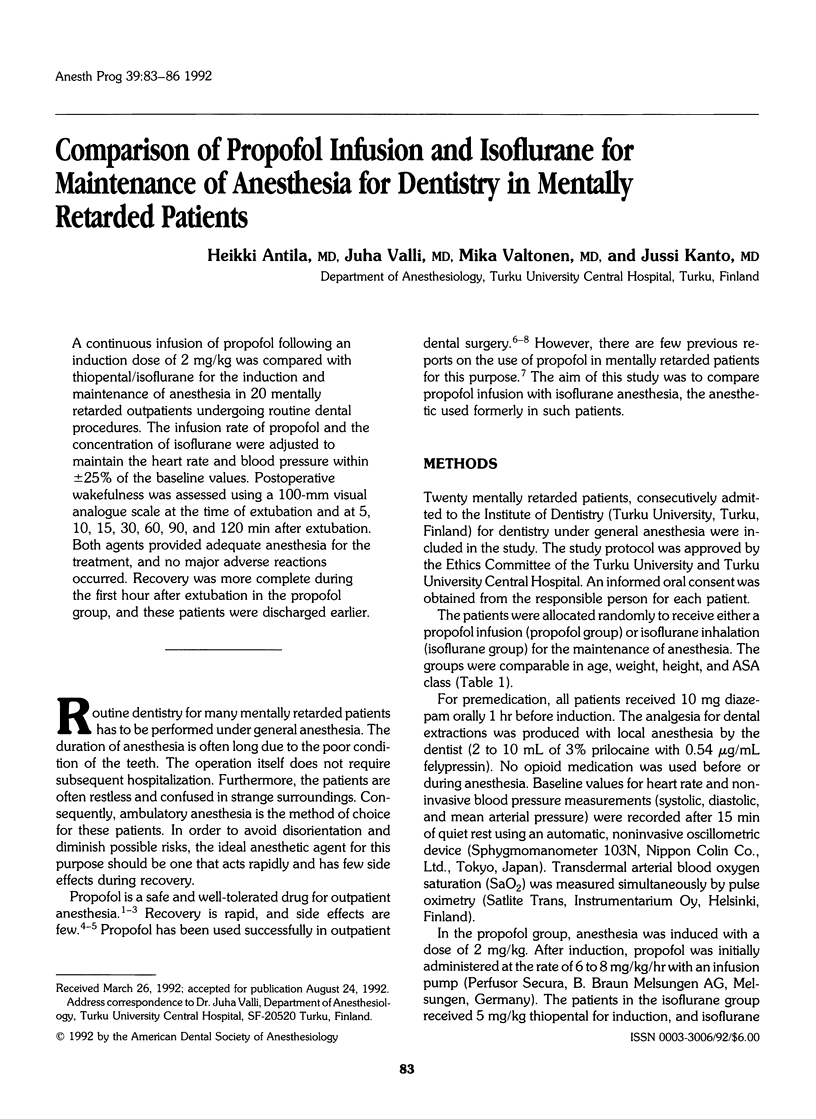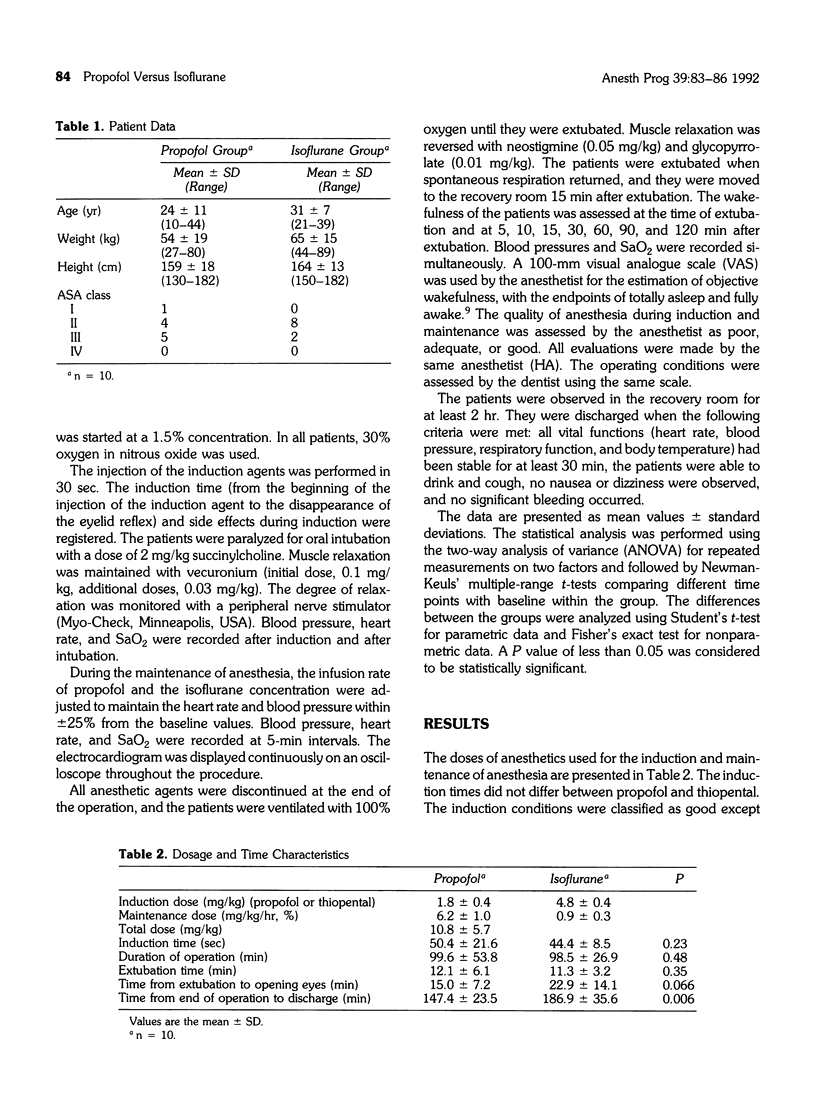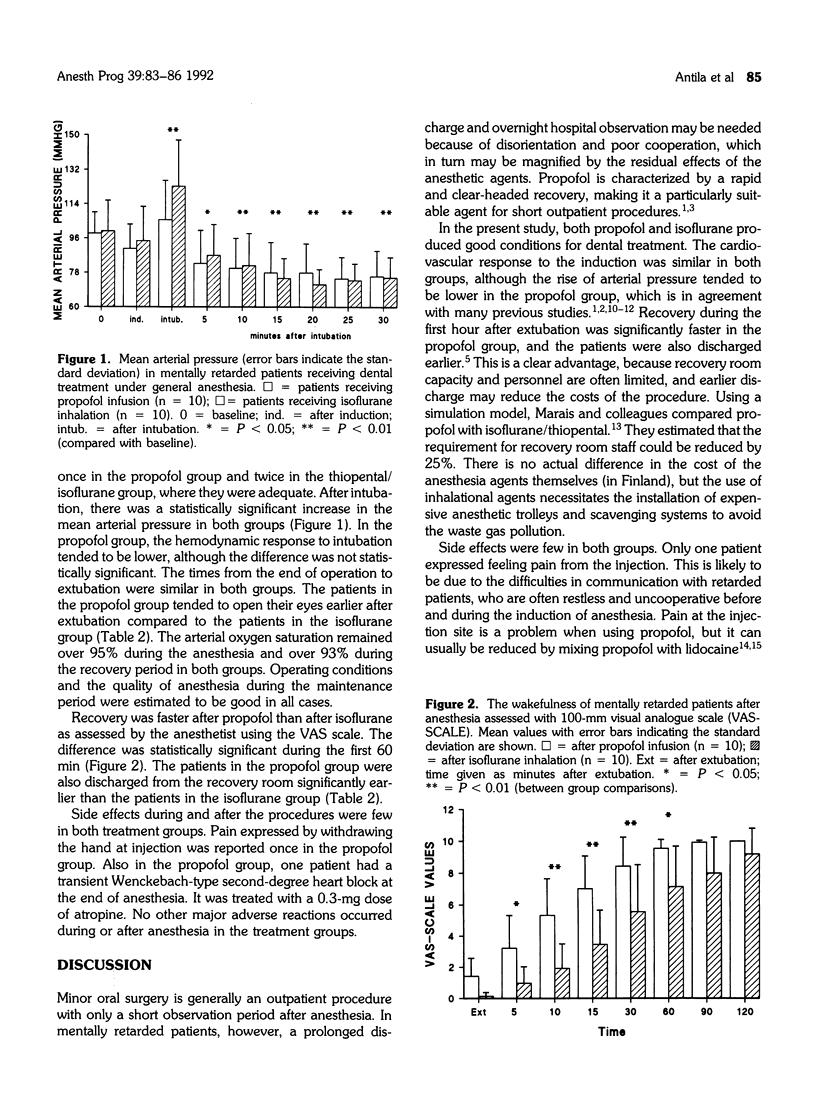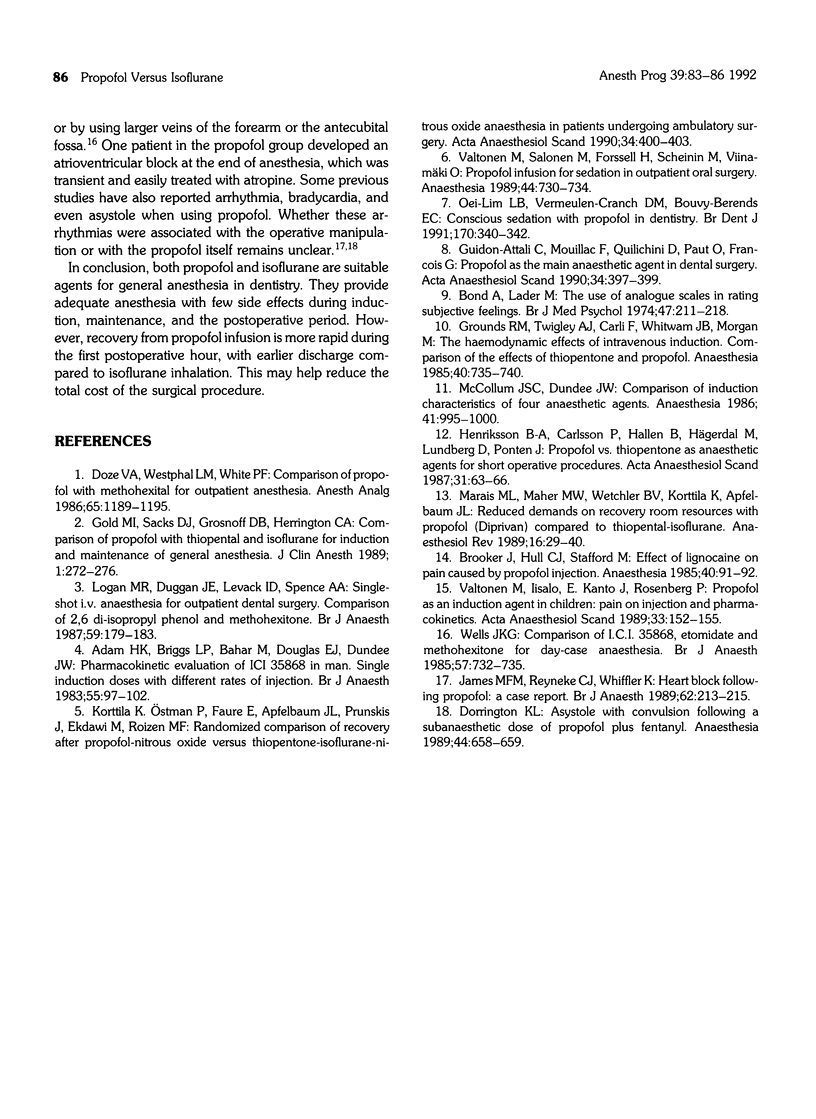Abstract
A continuous infusion of propofol following an induction dose of 2 mg/kg was compared with thiopental/isoflurane for the induction and maintenance of anesthesia in 20 mentally retarded outpatients undergoing routine dental procedures. The infusion rate of propofol and the concentration of isoflurane were adjusted to maintain the heart rate and blood pressure within +/- 25% of the baseline values. Postoperative wakefulness was assessed using a 100-mm visual analogue scale at the time of extubation and at 5, 10, 15, 30, 60, 90, and 120 min after extubation. Both agents provided adequate anesthesia for the treatment, and no major adverse reactions occurred. Recovery was more complete during the first hour after extubation in the propofol group, and these patients were discharged earlier.
Full text
PDF



Selected References
These references are in PubMed. This may not be the complete list of references from this article.
- Adam H. K., Briggs L. P., Bahar M., Douglas E. J., Dundee J. W. Pharmacokinetic evaluation of ICI 35 868 in man. Single induction doses with different rates of injection. Br J Anaesth. 1983 Feb;55(2):97–103. doi: 10.1093/bja/55.2.97. [DOI] [PubMed] [Google Scholar]
- Brooker J., Hull C. J., Stafford M. Effect of lignocaine on pain caused by propofol injection. Anaesthesia. 1985 Jan;40(1):91–92. doi: 10.1111/j.1365-2044.1985.tb10530.x. [DOI] [PubMed] [Google Scholar]
- Dorrington K. L. Asystole with convulsion following a subanesthetic dose of propofol plus fentanyl. Anaesthesia. 1989 Aug;44(8):658–659. doi: 10.1111/j.1365-2044.1989.tb13588.x. [DOI] [PubMed] [Google Scholar]
- Doze V. A., Westphal L. M., White P. F. Comparison of propofol with methohexital for outpatient anesthesia. Anesth Analg. 1986 Nov;65(11):1189–1195. [PubMed] [Google Scholar]
- Gold M. I., Sacks D. J., Grosnoff D. B., Herrington C. A. Comparison of propofol with thiopental and isoflurane for induction and maintenance of general anesthesia. J Clin Anesth. 1989;1(4):272–276. doi: 10.1016/0952-8180(89)90026-3. [DOI] [PubMed] [Google Scholar]
- Grounds R. M., Twigley A. J., Carli F., Whitwam J. G., Morgan M. The haemodynamic effects of intravenous induction. Comparison of the effects of thiopentone and propofol. Anaesthesia. 1985 Aug;40(8):735–740. doi: 10.1111/j.1365-2044.1985.tb10996.x. [DOI] [PubMed] [Google Scholar]
- Guidon-Attali C., Mouillac F., Quilichini D., Paut O., François G. Propofol as the main anaesthetic agent in dental surgery. Acta Anaesthesiol Scand. 1990 Jul;34(5):397–399. doi: 10.1111/j.1399-6576.1990.tb03110.x. [DOI] [PubMed] [Google Scholar]
- Henriksson B. A., Carlsson P., Hallén B., Hägerdal M., Lundberg D., Pontén J. Propofol vs thiopentone as anaesthetic agents for short operative procedures. Acta Anaesthesiol Scand. 1987 Jan;31(1):63–66. doi: 10.1111/j.1399-6576.1987.tb02522.x. [DOI] [PubMed] [Google Scholar]
- James M. F., Reyneke C. J., Whiffler K. Heart block following propofol: a case report. Br J Anaesth. 1989 Feb;62(2):213–215. doi: 10.1093/bja/62.2.213. [DOI] [PubMed] [Google Scholar]
- Korttila K., Ostman P., Faure E., Apfelbaum J. L., Prunskis J., Ekdawi M., Roizen M. F. Randomized comparison of recovery after propofol-nitrous oxide versus thiopentone-isoflurane-nitrous oxide anaesthesia in patients undergoing ambulatory surgery. Acta Anaesthesiol Scand. 1990 Jul;34(5):400–403. doi: 10.1111/j.1399-6576.1990.tb03111.x. [DOI] [PubMed] [Google Scholar]
- Logan M. R., Duggan J. E., Levack I. D., Spence A. A. Single-shot i.v. anaesthesia for outpatient dental surgery. Comparison of 2,6 di-isopropyl phenol and methohexitone. Br J Anaesth. 1987 Feb;59(2):179–183. doi: 10.1093/bja/59.2.179. [DOI] [PubMed] [Google Scholar]
- McCollum J. S., Dundee J. W. Comparison of induction characteristics of four intravenous anaesthetic agents. Anaesthesia. 1986 Oct;41(10):995–1000. doi: 10.1111/j.1365-2044.1986.tb12740.x. [DOI] [PubMed] [Google Scholar]
- Oei-Lim L. B., Vermeulen-Cranch D. M., Bouvy-Berends E. C. Conscious sedation with propofol in dentistry. Br Dent J. 1991 May 11;170(9):340–342. doi: 10.1038/sj.bdj.4807526. [DOI] [PubMed] [Google Scholar]
- Valtonen M., Iisalo E., Kanto J., Rosenberg P. Propofol as an induction agent in children: pain on injection and pharmacokinetics. Acta Anaesthesiol Scand. 1989 Feb;33(2):152–155. doi: 10.1111/j.1399-6576.1989.tb02879.x. [DOI] [PubMed] [Google Scholar]
- Valtonen M., Salonen M., Forssell H., Scheinin M., Viinamäki O. Propofol infusion for sedation in outpatient oral surgery. A comparison with diazepam. Anaesthesia. 1989 Sep;44(9):730–734. doi: 10.1111/j.1365-2044.1989.tb09257.x. [DOI] [PubMed] [Google Scholar]
- Wells J. K. Comparison of ICI 35868, etomidate and methohexitone for day-case anaesthesia. Br J Anaesth. 1985 Aug;57(8):732–735. doi: 10.1093/bja/57.8.732. [DOI] [PubMed] [Google Scholar]


